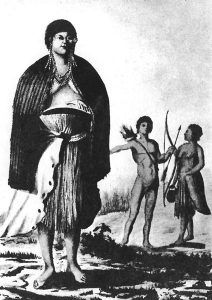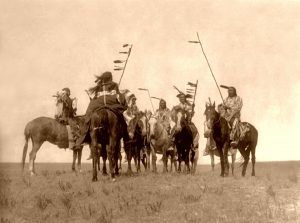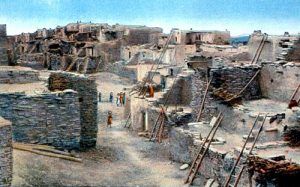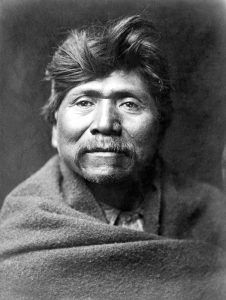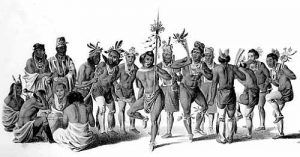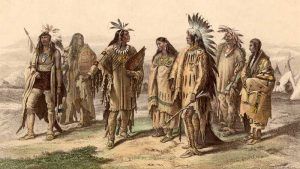Summaries: A B C D E-I J-K L-M N O P Q-R S T-V W X-Z
Erie – With French contact limited to one brief meeting, very little is known for certain about the Erie except they were important and were there. The Dutch and Swedes also heard about them through their trade with the Susquehannock but never met the Erie. All information about their social and political organization has come from early Jesuit accounts of what the Huron had told them.
Eyak – The Eyak, literally “inhabitants of Eyak Village,” are a Native American indigenous group traditionally located on the Copper River Delta near Cordova, Alaska. The Eyak’s territory reached present-day Cordova east to the Martin River and north to Miles Glacier. The Eyak moved out of the interior down the Copper River to the coast. There, they harvested the rich salmon fishing grounds. When the Russians arrived, they recognized the Eyak as a distinct culture and described their territory on their maps. They also traded with the Eyak and sent them missionaries. Because of their small population, they were often raided, and their territory boundaries were under pressure from the Chugach to the west. The Tlingit, on the east side, had better relations with the Eyak, leading to intermarriage and assimilation of many Eyak. This pushed the Eyak’s territorial boundary further west and contributed to the Eyak’s decline. When the Americans arrived, they started canneries and competed with the Eyak for salmon. This, combined with integration with, and diseases introduced by non-native settlers, led to further decline. As populations decreased, the remaining Eyak began congregating near the village of Orca. In 1880, the population of the village of Alaganik was recorded at 117, and by 1890, it had declined to 48. In 1900, the total population was estimated at 60. As more settlers arrived, this last village became the town of Cordova. As of 1996, there were 120 living, partial Eyak descendants. The last full-blooded Eyak died in 2007.
Eno – A tribe associated with the Adshusheer and Shakori in North Carolina in the 17th century, historians believe it doubtful that the Eno and the Shakori were of Siouan stock, as they seem to have differed in physique and habits from their neighbors. However, their alliances were all with Siouan tribes. Little is known of them as they disappeared from history as tribal bodies about 1720, having been incorporated with the Catawba on the south or with the Saponi and their confederates on the north. However, they still retained their distinct dialect in 1743. The Eno and Shakori were first mentioned in 1654 when the Tuscarora tribe described them as living next to the Shakori, “a great nation ” by whom the northern advance of the Spaniards was valiantly resisted. The next mention of these two tribes was in 1672, stating they lived south of the Occaneechi near the headwaters of the Tar and Neuse rivers. The general locality is still indicated in the names of Eno River and Shocco Creek. In 1701, the Eno and Shakori confederated, and the Adshusheer united in the same locality. Their village, called Adshusheer, was on Eno River, about 14 miles east of the Occaneechi village, near present-day Hillsboro’s site.
Eskimo – See Inuit
Esselen – The Esselen were a tribe of California Indians who are indigenous to the Santa Lucia Mountains of the region now known as Big Sur in Monterey County, California.
Eufaula – The Eufaula tribe, a Muscogean-speaking people, were part of the Muscogee Creek Confederacy and originally lived in the southeastern United States. Their descendants primarily live in Oklahoma today.
Eyeish – The Eyeish were a tribe of the Caddo Confederacy but spoke a different dialect, now extinct, that was very different from the dialects of the other Caddo tribes; hence, it is probable they were part of an older confederacy that was incorporated into the Caddo when the latter became dominant.
Five Civilized Tribes – A group of southeastern tribes noted by whites for their advanced culture. All were Muskogean-speaking peoples except for the Cherokee. The five tribes included the Cherokee, Chickasaw, Choctaw, Creek, and Seminole.
Fox – An Algonquian tribe, they were so named because once, while some Wagohugi, members of the Fox clan, were hunting, they met the French, who asked who they were. The Indians gave the name of their clan, and ever since, the name of the Fox has known the whole tribe. Their own name is Měshkwa`kihŭg, which means red-earth people” because of the kind of earth from which they are supposed to have been created. They were known to the Chippewa and other Algonquian tribes as Utŭgamig, or “people of the other shore.”
Fremont – The Fremont people lived throughout Utah and adjacent areas of Idaho, Colorado, and Nevada from 700 to 1300 AD. The culture was named for the Fremont River and its valley, where many of the first Fremont sites were discovered.
Gros Ventre, aka Ahe, A’aninin, Ahahnelin, A’ane, Atsina – Pronounced “Grow Vaunt,” the word means “big belly” in French. The Gros Ventre were kinfolk of the Arapaho and called themselves A’aninin, the White Clay People.
Guale – Guale was a historic Native American chiefdom of Mississippian culture peoples located along the coast of present-day Georgia and the Sea Islands. Spanish Florida established its Roman Catholic missionary system in the chiefdom in the late 16th century. During the late 17th century and early 18th century, Guale society was shattered by extensive epidemics of new infectious diseases and attacks by other tribes. Some surviving remnants migrated to the mission areas of Spanish Florida, while others remained near the Georgia coast. Joining with other survivors, they became known as the Yamasee, an ethnically mixed group that emerged during ethnogenesis. See more HERE.
Hidatsa – Also known as the Minitari and a band of the Gros Ventre, the Hidatsa spoke a Siouan language. Occupying several agricultural villages on the upper Missouri River in North Dakota, they were in close alliance with the Arikara and the Mandan tribes.
Ho-Chunk – Also known as Hoocaagra or Winnebago, the Ho-Chunk are a Siouan-speaking Native American people whose historic territory included parts of Wisconsin, Minnesota, Iowa, and Illinois. Today, there are two separate federally recognized tribes, including the Ho-Chunk Nation of Wisconsin and the Winnebago Tribe of Nebraska.
Hohokam – Around 400 B.C., these Indians migrated from northern Mexico and settled at a place now called Snaketown, near Phoenix, Arizona. This group, who lived in pit houses, wisely invented an early form of irrigation, digging canals up to ten miles in length, then damming and directing the water through rows of crops. They made pottery using a unique dye from the saguaro cactus. Their culture lasted almost 2,000 years and are most likely the ancestors of the Pima and Papago tribes.
Hopi – The Hopi occupancy of Arizona makes it the longest authenticated history of occupation of a single area by any Native American tribe in the United States. The Hopi located their villages on mesas for defensive purposes, but clans and families also utilized the surrounding land for medicinal and religious purposes.
Houma – Originally, the Houma were from east-central Mississippi and were of the Chakchiuma. By 1682 the Houma had separated from the Chakchiuma and were living a few miles inland from the east bank of the Mississippi River, just below the present border between Mississippi and Louisiana. Over time, they drifted south into Terrebonne and Lafourche Parishes southwest of New Orleans. Most of their descendants are still there today and live in or near Montagne, Golden Meadow, and Dulac-Grand Caillou.
Hualapai, aka Walapai – The Hualapai, meaning “People of the Tall Pine,” have lived along the Colorado River and the Grand Canyon for centuries. Their tribal capital is located at Peach Springs, Arizona, with a total population of some 1,600 members. Their economy is based on tourism, river rafting, cattle-ranching, hunting expeditions, timber-cutting, and the crafting of traditional and modern folk arts.
Huron – Many people today do not realize that Huron and Wyandot are the same people. Originally, more than a dozen Iroquoian-speaking tribes of southern Ontario referred to themselves as Wendat, meaning “island people” or “dwellers on a peninsula.”
lllinois-Illini-Illiniwek – Of the Algonquian languages family, the Illinois Confederation was a group of 12–13 Native American tribes who lived in the upper Mississippi River Valley. The five main tribes were the Cahokia, Kaskaskia, Michigamea, Peoria, and Tamaroa. During European contact in the 17th century, they were believed to have numbered over 10,000 people. However, by 1778, their numbers had dramatically declined due to wars and diseases. In 1832, the tribes joined together with the Peoria and ceded all of their remaining territory in Illinois. They are now part of the Peoria Tribe of Oklahoma.
Inuit/Eskimo – The Inuit are the indigenous peoples inhabiting the Arctic regions of Alaska, Greenland, and Canada, with close relatives in Russia. A common cultural heritage and a common language unite them. Over the years, they have been called “Eskimo” but prefer to be called by their own name, “Inuit,” meaning simply “people.” Traditionally, they have relied on fish, sea mammals, and land animals for food, heat, light, clothing, tools, and shelter. According to archaeological research, the origins of the Inuit lie in northwestern Alaska, where they lived in houses made of driftwood and sod. The Inuit began moving eastward into Arctic Canada about a thousand years ago. Within a few hundred years, they had replaced the earlier inhabitants of the region, a now-extinct people known as Tunit. By about 1250 AD, the first Inuit had entered Greenland through the Smith Sound area far northwest of the island. Here, they may have first encountered Viking hunters from the Norse colonies in southwest Greenland. In many areas, the old sod and whalebone winter houses were abandoned in favor of houses made of blocks of snow. They were easier to build as they could be put up anywhere, even on the sea ice and required only an hour or two to construct. Today, the Inuit continue to live in the Arctic regions, working in all sectors of the economy, though many still supplement their income through hunting. Tourism is a growing industry as guides take tourists on a dogsled and hunting expeditions and work with outfitting organizations.
Iowa/Ioway – Iowa, or Ayuwha, was a term borrowed by the French from the Dakota that signifies “Sleepy-ones.” The Iowa people are of Sioux stock and closely related to the Otoe and Missouri tribes. They moved about a great deal, mostly in the states of Iowa and Minnesota. They lost their lands in Minnesota and Missouri through various treaties with the U.S. Government. The Ioway practiced farming and lived in villages; however, bands that lived farther west adopted more of the customs of the Plains Indians. In 1836, another treaty assigned part of them a reservation along the Great Nemaha River in present-day Brown County, Kansas, and Richardson County, Nebraska.
Innu – The Montagnais and Naskapi have different tribal names but consider themselves part of the same culture, Innu. The Innu are indigenous people of eastern Quebec and Labrador, Canada. Most Innu people live in their traditional territory today, which they call Nitassinan.
Iroquois – The Iroquois or Haudenosaunee were a powerful northeast Native American confederacy. Before Europeans arrived, they lived in New York and Canada. Technically, “Iroquois” refers to a language rather than a particular tribe. Early on, it began to refer to a “nation” of Indians made up of five tribes, including the Seneca, Onondaga, Oneida, Cayuga, and Mohawk. Later they were joined by the Tuscarora. This group of tribes was known as the Iroquois Confederacy, the Iroquois League, or the Six Nations. Other tribes of Iroquoian stock not part of the Six Nations were the Huron, Tionontati, the Neutral Nation of Ontario; the Erie and Conestoga in Ohio and Pennsylvania; and the Meherrin, Nottoway, and Cherokee of Virginia and Carolina. Some 80,000 people in the United States today claim an Iroquois heritage.
Summaries: A B C D E-I J-K L-M N O P Q-R S T-V W X-Z
© Kathy Alexander/Legends of America, updated March 2024.
Also See:
Native Americans – The First Owners of America

